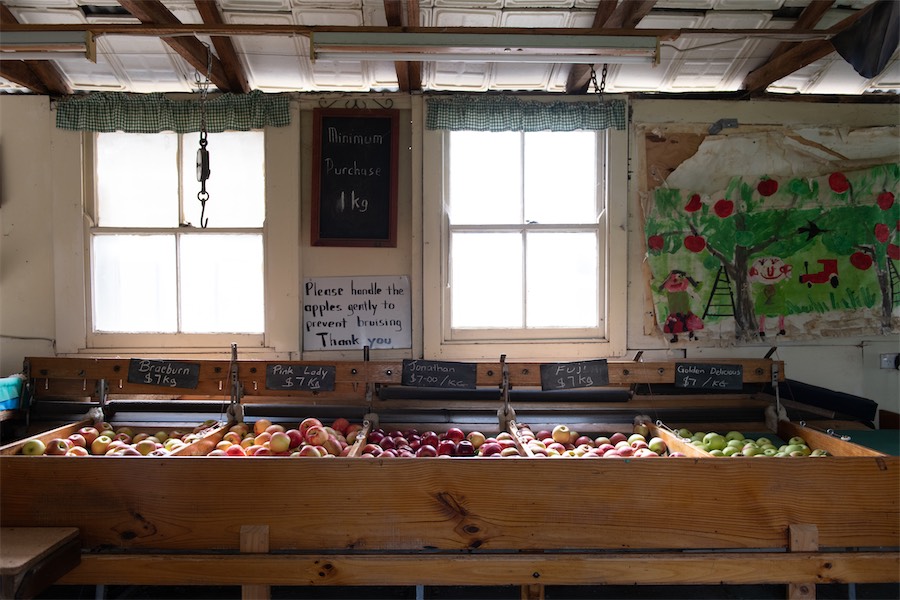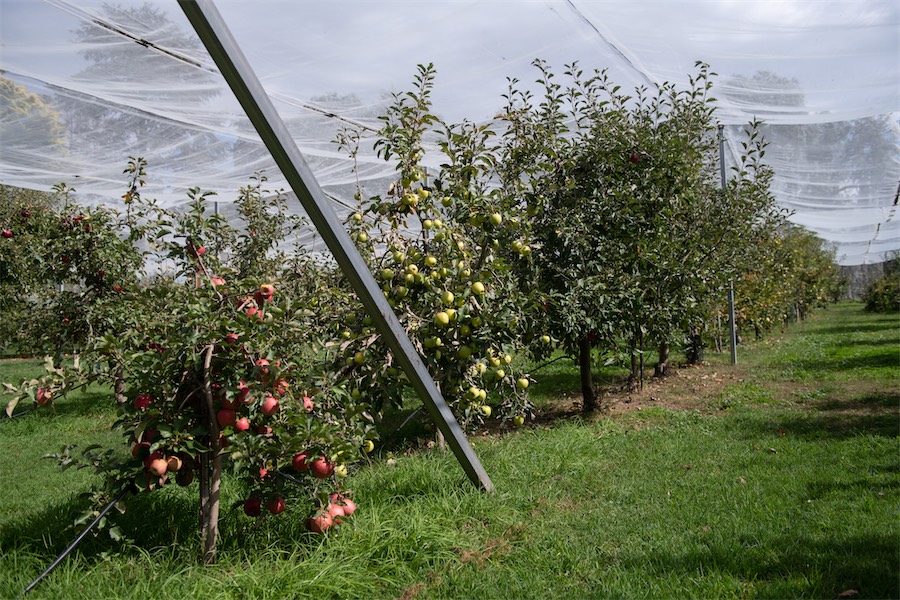
THERE’S something in the “apple-a-day” adage – founder of Beltana Grange Orchard in Pialligo, Bert Hauptmann has just turned 99 and says he still loves apples as much as when he was a boy.
He says he’s not quite himself on the day we meet, following a covid jab, but Bert, one of Canberra’s first apple growers, is always ready with a laugh and a story of the early days of the orchard.
When he first bought the Pialligo property in 1952, he grew veggies “down by the river flat, before the road came in”, he says, as well as raising a large flock of chickens, supplying eggs across Canberra for about 14 years, which “brought in a good income”.
He says his late wife Betty would collect and pack hundreds of eggs, twice a day.
“We used to collect the eggs at 11am and 3pm, and the morning haul was always the biggest,” he says.
“The eggs had to be sorted, weighed and packed in 30-dozen wooden cases. It kept us very busy.
“I started planting fruit trees, too. I thought they’d be good.”
He was on to something – nearly 70 years later, the orchard is still going strong in the hands of his son Michael and daughter-in-law Pam.

“The orchard has been here so long, we get people coming in with their grandkids who say ‘I used to come here with my mother years ago’,” he says.
“Pialligo has changed, it’s very busy now. Sometimes I look out the window and see all these cars going past, and wonder where they’re all going.”
The other orchards in Pialligo started at around the same time, Bert says, with “five poultry farms, two dairy farms, and two big market gardens, Lloyds and Hills, right down the bottom”.
He started out growing lots of different varieties of apples, including Cleopatras and Spartans, “one tree of this, and one of that”, he says.
“Fruit inspectors used to come round and check all the houses [which had fruit trees], to make sure they were spraying them properly to keep the bugs in check.
“This one fellow had come out and advised me; he said, if you want to make this a commercial orchard, get rid of all these odd apple varieties and concentrate on the ones that people want.”
Bert followed his advice, and Beltana Grange still grows Fuji, Pink Lady, Jonathans, Granny Smith, Bonza, Red Delicious, Golden Delicious and Braeburn, as well as Beurre Bosc and Packham pears. Bert was also one of the first to grow Gala apples in Australia.
He and Betty, who went on to have three children together, met in Sydney through their love of music, when Bert “used to be a singer and Betty was a pianist”, he says. Musical talent runs in the family; several of his grandchildren are professional musicians.
“In those days there used to be little concert parties, or recitals, on a Sunday afternoon and we met at one of those,” he says.
Moving to Canberra from Sydney, where only-child Bert grew up, came about through house-sitting for the in-laws.
He and Betty, daughter of Anglican Bishop of Canberra-Goulburn, Ernest Burgmann, had been married a year when her parents asked the young couple to look after their house in Mugga Way while they were visiting the UK for the Lambeth Conference in 1948.
“I came to Canberra for eight months and I’m still here,” he laughs, adding that many Canberrans say something similar.
Fitter and turner Bert, then 26, soon started teaching metalwork and woodwork at Canberra Grammar School.
“I was there doing repairs, and at the time they had no hobby classes,” he says.

“There were about 114 boarders and 75 day boys in the senior school and most of them were young country fellows. They were interested in doing practical lessons and the school asked if I’d teach them.”
While working at the school, Bert bought the 2.4-hectare (six acres) property in Pialligo, despite his colleagues’ collective horror at how far away it seemed.
“It wasn’t even called Pialligo. The address was just Block 16, Fyshwick,” he says.
“There was no Beltana Road, I think it was in the ’60s they named it and sealed the road. It used to be gravel and when the cool breeze came up in the summer you’d get covered in dust!
“I lost about an acre, and 75 trees, when they cut the corner off and put the road in.”
He remembers the “very small” airport in those days, and dropping off his father-in-law for a flight to Sydney on a DC-3.
“Everyone got into the plane, and suddenly about 12 men got out and the pilot came over and said: ‘We’ve got to get a rope because the starter motor is playing up’. It was like it was a lawnmower!” he says.
“They tied a rope around the base of the propeller but couldn’t get it going, so they got a jeep to tow it and it started, and they all got back in. The Bishop said to me: ‘Don’t tell mum!’.”
Bert still lives in the original house on the site and says the property has long been a family home as well as a business, with Michael and Pam having built a house and raised their family there. Bert’s other children, Elizabeth and Tim, also live in Canberra.
Today, the orchard has around 500 trees in dwarf varieties, which Bert says are easier to manage, pick and prune.
The fruit ripens on the trees between January and May, “apple season”, when Michael and Pam still hand-pick and sell them fresh, doing things the “old-fashioned way”, as Bert always did.
The orchard is kept netted to keep cockatoos out, Bert says, as they “only like the seeds and can destroy a whole tree of apples in 10 minutes”.

“Before we had netting we’d shout, ‘cockatoo alert’, and go out banging things to scare them off. They don’t like going under the nets because when they get frightened they panic and throw themselves upwards!” he says.
While he can’t work in the orchard any more, Bert still likes to keep an eye on things.
“I like to go all over the place,” he says. “I walk around the trees and see what’s going on.”
Who can be trusted?
In a world of spin and confusion, there’s never been a more important time to support independent journalism in Canberra.
If you trust our work online and want to enforce the power of independent voices, I invite you to make a small contribution.
Every dollar of support is invested back into our journalism to help keep citynews.com.au strong and free.
Thank you,
Ian Meikle, editor



![For graphic designer Tracy Hall, street art is like any artwork, her canvas has been swapped out for fences and plywood, her medium changing from watercolours to spray paint.
A Canberra resident for 13 years, Tracy has been a street and mural artist for the past five.
Her first exploration into grand-scale painting was at the Point Hut toilets in Banks five years ago. “They had just finished doing up the playground area for all the little kids and the words [of graffiti] that were coming up weren’t family friendly,” she says.
“So I ended up drawing this design and I got approval for the artwork.”
Many of Tracy’s time-consuming artworks are free, with thousands of her own dollars put into paint.
@traceofcolourdesigns
To read all about Tracy's fabulous street art, visit our website at citynews.com.au or tap the link in our bio! 🎨🖌
#canberranews #citynews #localstories #canberrastories #Citynews #localnews #canberra #incrediblewomen #journalism #canberracitynews #storiesthatmatter #canberralocals #artist #streetart #streetartist #StreetArtMagic](https://scontent.cdninstagram.com/v/t39.30808-6/490887207_1225841146218103_6160376948971514278_n.jpg?stp=dst-jpg_e35_tt6&_nc_cat=106&ccb=1-7&_nc_sid=18de74&_nc_ohc=yse5ujF1BOUQ7kNvwE8vMJJ&_nc_oc=AdmACWW3pCwuhoAJjTJgeYL0PrOjZetex1flAsV7seJ8OPT1_w_DCdBrY998OXsAdFw&_nc_zt=23&_nc_ht=scontent.cdninstagram.com&edm=ANo9K5cEAAAA&_nc_gid=M3Eat5CavCFLyQKem8wl7A&oh=00_AfEelLohW-0BM38EPlPqLO_ehfn2HbeGBZ7_42rmOJ7w8w&oe=68079794)




Leave a Reply